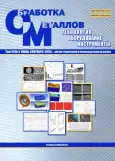Improvement of Efficiency of Ferromagnetic Surface Strengthening by Combined Magnetic-Dynamic Rolling
- Authors: Dovgalev A.M.1
-
Affiliations:
- Issue: Vol 20, No 3 (2018)
- Pages: 18-35
- Section: TECHNOLOGY
- URL: https://journal-vniispk.ru/1994-6309/article/view/302076
- DOI: https://doi.org/10.17212/1994-6309-2018-20.3-18-35
- ID: 302076
Cite item
Full Text
Abstract
About the authors
A. M. Dovgalev
Email: rct@bru.by
Ph.D. (Engineering), Associate Professor; Belarusian-Russian University, 43 Mira Ave., Mogilev, 212030, Republic of Belarus; rct@bru.by
References
- Смелянский В.М. Механика упрочнения деталей поверхностным пластическим деформированием. – М.: Машиностроение, 2002. – 300 с.
- Рыжов Э.В. Технологические методы повышения износостойкости деталей машин. – Киев: Наукова думка, 1984. – 272 с.
- Наукоемкие технологии в машиностроении / под ред. А.Г. Суслова. – М.: Машиностроение, 2012. – 528 с.
- Поляк М.С. Технология упрочнения. В 2 т. Т. 1. – М.: Машиностроение, 1995. – 832 с.
- Поляк М.С. Технология упрочнения. В 2 т. Т. 2. – М.: Машиностроение, 1995. – 688 с.
- Малыгин Б.В. Магнитное упрочнение инструмента и деталей машин. – М.: Машиностроение, 1989. – 112 с.
- Белый И.В., Фертик С.М., Хименко Л.Т. Справочник по магнитоимпульсной обработке металлов. – Харьков : Вища школа, 1977. – 320 с.
- Falaleev A.P., Meshkov V.V., Shymchenko A. Hyperplasticity effect under magnetic pulse straightening of dual phase steel // IOP Conference Series: Materials Science and Engineering. – 2016. – Vol. 153, N 1. – P. 10.
- Kleiner M., Beerwald C., Homberg W. Analysis of process parameters and forming mechanisms within the electromagnetic forming process // CIRP Annals – Manufacturing Technology. – 2005. – Vol. 24, iss. 1. – P. 225–228.
- Таранов А.С. Упрочнение валов методом ППД в ПМП // Тракторы и сельхозмашины. – 2009. – № 2. – С. 44–45.
- Aifantis E.C. The physics of plastic deformation // International Journal of Plasticity. – 1987. – Vol. 3. – P. 211–247.
- Chen H., Kysar J.W., Yao Y.L. Characterization of plastic deformation induced by microscale laser shock peening // Journal of Applied Mechanics. – 2004. – Vol. 71, iss. 5. – P. 713–723.
- Zhang W.X., Wang T.J., Chen X. Effect of surface/interface stress on the plastic deformation of nanoporous materials and nanocomposites // International Journal of Plasticity. – 2010. – Vol. 26, iss. 7. – P. 957–975.
- Effect of severe plastic deformation on the properties and structural developments of high purity Al and Al-Cu-Mg-Zr aluminium alloy / T. Kvackaj, J. Bidulská, R. Kociško, R. Bidulský // Aluminium Alloys: Theory and Applications. – Rijeka, Croatia, 2011. – Ch. 1. – P. 1– 26.
- Suwas S., Bhowmik A., Biswas S. Ultra-fine grain materials by severe plastic deformation: application to steels // Microstructure and Texture in Steels and Other Materials. – London; New York: Springer, 2009. – Ch. 19. – P. 325–344.
- Технология и инструменты для отделочно-упрочняющей обработки деталей поверхностным пластическим деформированием. В 2 т. Т. 1: справочник / под общ. ред. А.Г. Суслова. – М.: Машиностроение, 2014. – 480 с.
- Технология и инструменты для отделочно-упрочняющей обработки деталей поверхностным пластическим деформированием. В 2 т. Т. 2: справочник / под общ. ред. А.Г. Суслова. – М.: Машиностроение, 2014. – 444 с.
- Минаков А.П., Бунос А.А. Технологические основы пневмовибродинамической обработки нежестких деталей / под ред. П.И. Ящерицына. – Минск: Навука i тэхнiка, 1995. – 304 с.
- Патент 2068770 Российская Федерация. Способ поверхностного пластического деформирования и инструмент для его осуществления / А.М. Довгалев. – Опубл. 10.11.1996.
- Патент 2089373 Российская Федерация. Способ поверхностного пластического деформирования и инструмент для его осуществления / А.М. Довгалев. – Опубл. 10.09.1997.
- Довгалев А.М. Совмещенная отделочно-упрочняющая обработка деталей машин вибродинамическим накатыванием и вращающимся магнитным полем // Вестник Белорусско-Российского университета. – 2016. – № 4. – С. 15–23.
- Довгалев А.М. Магнитно-динамическое и совмещенное накатывание поверхностей нежестких деталей. – Могилев: Белорус.-Рос. ун-т, 2017. – 266 с.
- Лысак Л.И. Определение истинной ширины рентгеновских интерференционных линий с применением стандартного образца // Вопросы физики металлов и металловедения: сборник трудов. – Киев: АН УССР, 1955. – № 6. – С. 40–53.
- Кристаллография, рентгенография и электронная микроскопия / Я.С. Уманский, Ю.А. Скаков, А.Н. Иванов, Л.Н. Расторгуев. – М.: Металлургия, 1982. – 632 с.
- Кривоглаз М.А. Дифракция рентгеновских лучей и нейтронов в идеальных кристаллах. – Киев: Наукова думка, 1983. – 115 с.
Supplementary files






